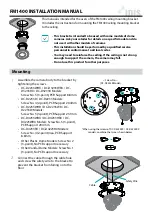
Problem
Possible Cause
Solution
There is no video.
Wire(s) may be
installed incorrectly.
Monitor input may be
on incorrect setting.
The motor may be
working improperly.
Re-check all wires and cables to
ensure that they are properly secure.
Verify that monitor is displaying the
correct input setting.
Remove power to the unit, re-apply
power, and allow the device to go
through its homing phase.
Horizontal lines appear on
the display
Incorrect dip switch
setting
Ensure the dip switch is set to PAL or
NTSC as appropriate. Refer to
Biphase/Bilinx Termination, page 44
Note! Over time, due to environmental factors such as wind and vibration, preset positions
may not always align with what they were at installation. Use AUX ON - 204 - Enter to correct
this. It takes 30-45 seconds to cycle through this process, during which time there is no user
control. Once it has finished the process and corrected for the effect of any environmental
factors, the user regains full control.
Low and High Temperatures
Systems in the UPH line are switched on by simply connecting the power supply, and switched
off by disconnecting the power supply. When the UPH is powered up in an environment below
0 °C, the device checks it’s internal components to make sure that they are warm enough to
start without damage. If the internal components’ temperatures are too low, the OSD displays
a warning message and the UPH automatically enters its de-icing mode. In de-icing mode the
UPH is powered in an attempt to raise its internal temperature. A timer appears on the screen
and counts down showing how much time remains for de-icing to complete.
Notice!
De-icing can take between 30 and 105 minutes, after which time it is ready for use, assuming
that a safe internal temperature is reached; otherwise, it is too cold to safely operate the UPH
and it remains off.
Notice!
High temperatures can also have a negative effect on camera image. If the ambient (outside)
air temperature exceeds 40 leg Celsius (104° F), the HSPT will continue to operate; however,
some unusual effects may appear on the video signal. These are blemishes that appear as very
small white dots on the video picture. They are usually only noticeable during, and a few
hours after, dusk, when the overall scene becomes darker, and the housing is still cooling
down as the sun goes down.
Continued exposure of the HSPT to excessive ambient (outside) air temperatures will effect
the long-term reliability of the HSPT, cause blemishes to become more severe, and may
introduce fixed pattern noise (FPN) on the video signal.
Solution: via Bilinx change the SensUp setting in the camera to OFF; this reduces the number
and intensity of the blemishes.
15.1
74
en | Troubleshooting
High-Speed Positioning System
(HSPS)
2013.11 | 5.2 | F.01U.291.981
Operation Manual
Bosch Security Systems, Inc.
Summary of Contents for UPH Series
Page 1: ...High Speed Positioning System HSPS UPH Series ...
Page 2: ...en Operation Manual ...
Page 80: ......
Page 81: ......









































